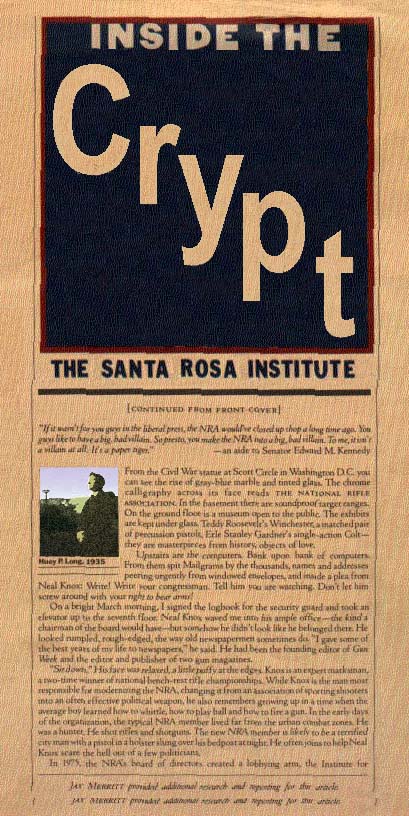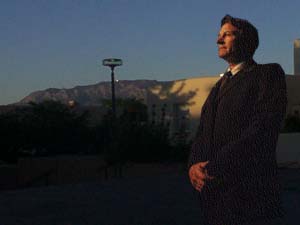

Famous Cases | Historical Tales | Vampires | Zombies
 |  |
Famous Cases | Historical Tales | Vampires | Zombies |
 |
![]() For a long time, I dismissed the crypt as the stuff of urban legend. But the more I thought about it, the more it made sense. After all, it stands to reason that a place doing research on vampires and zombies would need to keep some of the bloodthirsty critters around. So now that I am sitting in the office of the Institute's CEO, Edward Westhead, M.D., Ph.D, it seems only fair to bring it up. I wait for a pause in the conversation and ask the doctor, in a jocular tone, "so what's the story with the crypt?"
For a long time, I dismissed the crypt as the stuff of urban legend. But the more I thought about it, the more it made sense. After all, it stands to reason that a place doing research on vampires and zombies would need to keep some of the bloodthirsty critters around. So now that I am sitting in the office of the Institute's CEO, Edward Westhead, M.D., Ph.D, it seems only fair to bring it up. I wait for a pause in the conversation and ask the doctor, in a jocular tone, "so what's the story with the crypt?"
![]() The doctor answers with a smile I read as condescending. But what he says next surprises me.
The doctor answers with a smile I read as condescending. But what he says next surprises me.
![]() "Would you like to see it?"
"Would you like to see it?"
![]() If your idea of a scientist is an egghead with thick glasses and hair growing out of his ears, then let me introduce you to Dr. Edward Westhead. The 43-year-old Institute boss eschews white lab frocks for Armani suits, drives a $125,000 Ferrari and looks more like Dr. Kildare than Dr. Frankenstein. But lest you think he's some kind of photogenic figurehead, take a look at the plaques on his office wall. There's the bachelor's from Dartmouth, summa cum laude, and the medical degree from Columbia and the Ph.D from Harvard, all before he was 25. And yes, that's him standing atop Mount Everest and K2, and him at the controls of his twin-engine Cessna. Give him a break, the man gets bored easily. Treating patients, doing cancer research and publishing papers gets old fast. It was only a matter of time that he turned to medicine's Holy Grail: immortality. Three years ago, Westhead left a plum job at Harvard to shepherd the Institute into the 21st Century. "This is where it's all going to happen," he tells me as we walk across the mercifully shady Institute campus. "Right here. The keys to all the mysteries. We're so close I can taste it."
If your idea of a scientist is an egghead with thick glasses and hair growing out of his ears, then let me introduce you to Dr. Edward Westhead. The 43-year-old Institute boss eschews white lab frocks for Armani suits, drives a $125,000 Ferrari and looks more like Dr. Kildare than Dr. Frankenstein. But lest you think he's some kind of photogenic figurehead, take a look at the plaques on his office wall. There's the bachelor's from Dartmouth, summa cum laude, and the medical degree from Columbia and the Ph.D from Harvard, all before he was 25. And yes, that's him standing atop Mount Everest and K2, and him at the controls of his twin-engine Cessna. Give him a break, the man gets bored easily. Treating patients, doing cancer research and publishing papers gets old fast. It was only a matter of time that he turned to medicine's Holy Grail: immortality. Three years ago, Westhead left a plum job at Harvard to shepherd the Institute into the 21st Century. "This is where it's all going to happen," he tells me as we walk across the mercifully shady Institute campus. "Right here. The keys to all the mysteries. We're so close I can taste it."
 |
| As the sun sets on the old ways, Dr. Edward Westhead looks to a new future for the Institute |
![]() There is rarefied air to the Institute that belies its location off a rather squalid stretch of old Route 66 in Albuquerque. The Institute "campus" consists of about a dozen stately adobe buildings looking out on shaggy old cottonwoods and a duck pond. Only one building seems incongruous: a lowslung concrete edifice crouched ashamedly at the far northwest corner of the campus. When we arrive there, Dr. Westhead presses his face into some sort of glass box next to the entrance. "Retinal scan," he says, as the heavy doors wheeze open. Retinal scan! I thought these things only existed in James Bond movies. Inside, a team of glowering security guards give me the once-over, after which Dr. Westhead leads me through a series of security doors and down a freight elevator to a dusty subterranean hallway crowded with obsolete or broken lab equipment. "This is it," Dr. Westhead says, portentously, as we stand before a door marked AUTHORIZED PERSONNEL ONLY. The door opens on a darkened room and my hand flies up to my neck as I envision writhing vampires driven to distraction by the smell of fresh blood. But the room is empty except for about a dozen squat, stainless-steel containers. Dr. Westhead goes to one, removes the lid, and pulls out a tray of tiny plastic vials. The vials, suspended in tanks of liquid nitrogen, contain clusters of frozen cells from vampires and zombies. "In the Fifties, when the FVZA was going about its business, it occurred to someone that before they incinerated every last vampire and zombie, perhaps they should collect some blood and tissue samples for posterity. And this is it. The very basis of all our research." He holds a vial up for my inspection. "If I were to inject this into your veins, you would become a vampire. So you can see why we have so much security."
There is rarefied air to the Institute that belies its location off a rather squalid stretch of old Route 66 in Albuquerque. The Institute "campus" consists of about a dozen stately adobe buildings looking out on shaggy old cottonwoods and a duck pond. Only one building seems incongruous: a lowslung concrete edifice crouched ashamedly at the far northwest corner of the campus. When we arrive there, Dr. Westhead presses his face into some sort of glass box next to the entrance. "Retinal scan," he says, as the heavy doors wheeze open. Retinal scan! I thought these things only existed in James Bond movies. Inside, a team of glowering security guards give me the once-over, after which Dr. Westhead leads me through a series of security doors and down a freight elevator to a dusty subterranean hallway crowded with obsolete or broken lab equipment. "This is it," Dr. Westhead says, portentously, as we stand before a door marked AUTHORIZED PERSONNEL ONLY. The door opens on a darkened room and my hand flies up to my neck as I envision writhing vampires driven to distraction by the smell of fresh blood. But the room is empty except for about a dozen squat, stainless-steel containers. Dr. Westhead goes to one, removes the lid, and pulls out a tray of tiny plastic vials. The vials, suspended in tanks of liquid nitrogen, contain clusters of frozen cells from vampires and zombies. "In the Fifties, when the FVZA was going about its business, it occurred to someone that before they incinerated every last vampire and zombie, perhaps they should collect some blood and tissue samples for posterity. And this is it. The very basis of all our research." He holds a vial up for my inspection. "If I were to inject this into your veins, you would become a vampire. So you can see why we have so much security."
![]() As we head back to the elevator, Dr. Westhead's takes notice of my disappointment and suggests one more stop on the itinerary. Moments later, we are in another room, this one lined with metal shelves. Westhead switches the light on, and there before us is a truly macabre display of vampire and zombie remains: a severed vampire head, fangs bared, eyes bulging; the leathery, decomposed hand of a zombie. There are eyes, brains and hearts, all suspended in the same cloudy greenish formaldehyde. "Is this more along the lines of what you wanted to see," he asks. "Uh, yeah," I murmur, fully aware that I'll have nightmares about this for the next month.
As we head back to the elevator, Dr. Westhead's takes notice of my disappointment and suggests one more stop on the itinerary. Moments later, we are in another room, this one lined with metal shelves. Westhead switches the light on, and there before us is a truly macabre display of vampire and zombie remains: a severed vampire head, fangs bared, eyes bulging; the leathery, decomposed hand of a zombie. There are eyes, brains and hearts, all suspended in the same cloudy greenish formaldehyde. "Is this more along the lines of what you wanted to see," he asks. "Uh, yeah," I murmur, fully aware that I'll have nightmares about this for the next month.
![]() Later, over lunch at the Institute's cafeteria, Dr. Westhead expresses misgivings about letting me see the crypt, and it's not hard to figure out why. Though vampires and zombies provide the basis for its existence, the Institute has recently begun distancing itself from the undead. There are no longer any mention of vampires or zombies in any Institute literature. A museum honoring the Federal Vampire and Zombie Agency has been closed down. The Institute does not want images of leering vampires or flesh-eating zombies to poison its case as it pushes Congress for permission to take its research from test tubes and petri dishes into animals.
Later, over lunch at the Institute's cafeteria, Dr. Westhead expresses misgivings about letting me see the crypt, and it's not hard to figure out why. Though vampires and zombies provide the basis for its existence, the Institute has recently begun distancing itself from the undead. There are no longer any mention of vampires or zombies in any Institute literature. A museum honoring the Federal Vampire and Zombie Agency has been closed down. The Institute does not want images of leering vampires or flesh-eating zombies to poison its case as it pushes Congress for permission to take its research from test tubes and petri dishes into animals.
![]() No issue has so thoroughly divided the Institute as that of animal testing. When President Reagan signed legislation in 1986 overturning the ban on research, it was with the understanding that all work would be done under strict supervision in the lab. But Dr. Westhead claims that the lab research has gone as far as it can go. "We've developed a product, Genuflex, we've tested it thoroughly in the lab, and now it's time to see what effect it has on living organisms."
No issue has so thoroughly divided the Institute as that of animal testing. When President Reagan signed legislation in 1986 overturning the ban on research, it was with the understanding that all work would be done under strict supervision in the lab. But Dr. Westhead claims that the lab research has gone as far as it can go. "We've developed a product, Genuflex, we've tested it thoroughly in the lab, and now it's time to see what effect it has on living organisms."
![]() Standing in his way is an unlikely coalition of conservatives opposed to the project on religious grounds and environmentalists against testing on animals. The strange bedfellows have teamed up to sponsor a bill to ban testing of altered vampire DNA on animals. Their opposition truly rankles Dr Westhead. "Vampires do not age on a cellular level," he says, spearing a tomato on his fork for emphasis. "It would be foolish not to explore the reasons for this. We could do the research here, in a controlled, professional setting, or let the quacks do it. Either way, it's going to get done." But what if the research works, and an anti-aging drug is discovered. Who would be eligible to get it? And how much would it cost? "Obviously, it would be expensive, at least initially," he admits. "When private investors have committed millions of dollars to a project, it's reasonable for them to want a return on their investment when that project bears fruit." So only the rich would be eligible for immortality? "It may seem undemocratic, but in time, these things have a way of working themselves out," he says, obliquely. And if Genuflex is successful, won't that exacerbate the problems of overpopulation, pollution, dwindling resources, etc? "We'll cross that bridge when we come to it," he says, rather curtly. And then, perhaps feeling chastened, the doctor sets down his fork and assumes an attitude of prayer. "Look, the survival instinct is fundamental to all of us. Those people saying they accept death, that death is a part of life, they're only saying that because they have no choice. I guarantee you, if you gave them a choice, not a one would choose death. Not a one."
Standing in his way is an unlikely coalition of conservatives opposed to the project on religious grounds and environmentalists against testing on animals. The strange bedfellows have teamed up to sponsor a bill to ban testing of altered vampire DNA on animals. Their opposition truly rankles Dr Westhead. "Vampires do not age on a cellular level," he says, spearing a tomato on his fork for emphasis. "It would be foolish not to explore the reasons for this. We could do the research here, in a controlled, professional setting, or let the quacks do it. Either way, it's going to get done." But what if the research works, and an anti-aging drug is discovered. Who would be eligible to get it? And how much would it cost? "Obviously, it would be expensive, at least initially," he admits. "When private investors have committed millions of dollars to a project, it's reasonable for them to want a return on their investment when that project bears fruit." So only the rich would be eligible for immortality? "It may seem undemocratic, but in time, these things have a way of working themselves out," he says, obliquely. And if Genuflex is successful, won't that exacerbate the problems of overpopulation, pollution, dwindling resources, etc? "We'll cross that bridge when we come to it," he says, rather curtly. And then, perhaps feeling chastened, the doctor sets down his fork and assumes an attitude of prayer. "Look, the survival instinct is fundamental to all of us. Those people saying they accept death, that death is a part of life, they're only saying that because they have no choice. I guarantee you, if you gave them a choice, not a one would choose death. Not a one."
![]() Later, walking past the duck pond, Dr. Westhead and I stop to watch a toddler throw bread crumbs to some grateful geese under the watchful eye of his grandparents. The sight seems to inspire the doctor and soon he is talking of a world in which the average person lives two or three centuries, free from disease. It is this vision, he says, that drives him. "Bottom line, I get up every morning before my alarm goes off. I can't wait to get to work." Isn't he worried about his opponents? "The opposition is certainly spirited, but we have an ace in the hole," he says, watching the little boy giggling in glee as the geese fight over the scraps. "Grandchildren." Come again? "Most of these people in Congress have 'em, and they want to be around to see them grow up." He laughs, and with that he is off to meet with the lobbyists who will do the heavy lifting for him in Washington.
Later, walking past the duck pond, Dr. Westhead and I stop to watch a toddler throw bread crumbs to some grateful geese under the watchful eye of his grandparents. The sight seems to inspire the doctor and soon he is talking of a world in which the average person lives two or three centuries, free from disease. It is this vision, he says, that drives him. "Bottom line, I get up every morning before my alarm goes off. I can't wait to get to work." Isn't he worried about his opponents? "The opposition is certainly spirited, but we have an ace in the hole," he says, watching the little boy giggling in glee as the geese fight over the scraps. "Grandchildren." Come again? "Most of these people in Congress have 'em, and they want to be around to see them grow up." He laughs, and with that he is off to meet with the lobbyists who will do the heavy lifting for him in Washington.
![]() It would be foolish to bet against him.
It would be foolish to bet against him.